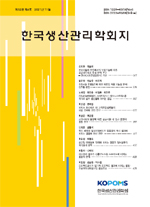
공급망 리스크가 국가 물류 성과에 미치는 영향에 대한 연구
Effect of Supply Chain Risk on National Logistics Performance: Using the Logistics Performance Index of the Member Countries of the OECD
본 연구는 경제협력개발기구(OECD) 회원국의 물류 효율성의 변화를 분석하여 물류 정책 수립 및 관리로 각 회원국의공급망 리스크에 물류 성과가 얼마나 크게 영향을 받는지에 대해 살펴보았다. 이를 위해 세계은행(World Bank)에서 배포하는 물류성과지수를 활용하여 물류 서비스의 역량과 무역 및 운송 인프라의 품질을 투입변수로, 물류성과지수 종합지수를 산출변수로 사용하는 맘퀴스트 생산성 분석을 수행하였다. 분석 결과, OECD 회원국의 생산성 변화의 추이가 기술변화지수의 추이와 매우 흡사한 것을 확인하였다. 또한, 아시아, 유럽, 오세아니아, 남아메리카에 속한 국가들은 생산성변화의 추이가 기술변화지수의 추이와 비슷했지만, 북아메리카에 속한 국가들은 효율성 변화 지수의 추이와 비슷함을 확인하였다. 추가 분석 결과, 배송 준비의 용이성 변수가 생산성에 부정적인 영향을, 정시성 변수는 긍정적인 영향을 미치는 것을 확인할 수 있었다.
This study analyzed changes in logistics efficiency in OECD member countries and examined how much logistics performance is affected by supply chain risks in each country. This study was analyzed using the Logistics Performance Index distributed by the World Bank. Malmquist productivity analysis was performed using “Logistics quality and competence” and “Infrastructure” as input factors and “overall LPI score” as an output factor. As a result, it was confirmed that the trend of productivity changes in OECD countries was very similar to that of the technology change index. And it was confirmed that countries in Asia, Europe, Oceania, and South America had similar trends in productivity changes, but countries in North America had similar trends in efficiency changes. In addition, we analyzed how risk factors were affected by productivity changes by performing Tobit regression analysis, As a result, international shipments factor had a negative effect and timeliness factor had a positive effect.
Ⅰ. 서론
Ⅱ. 선행연구
Ⅲ. 연구모형 및 자료수집
Ⅳ. 분석결과
Ⅴ. 결론
참고문헌